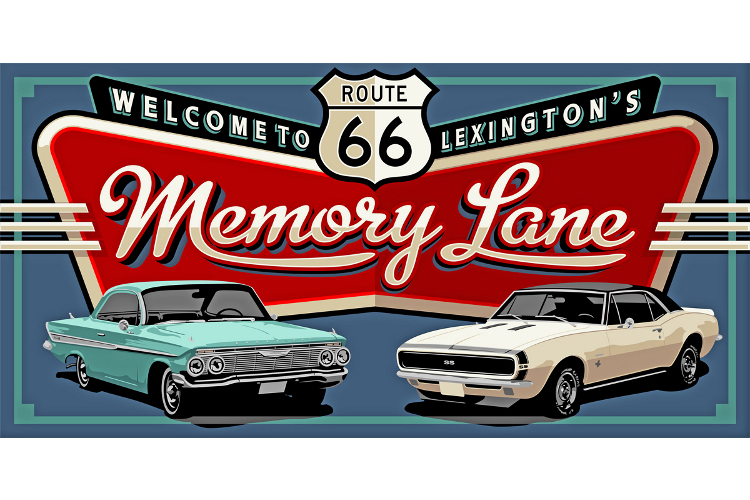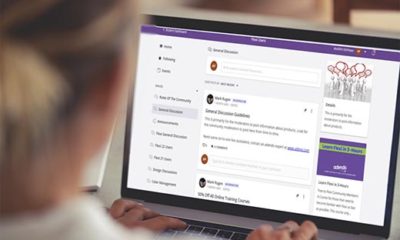Best Practices
Art Form
How three sign designers chose their software and defined a creative process.
Published
5 years agoon

The music is blaring.
The lights are off.
The office door, typically open, is closed.
Pablo Guerrero is in his happy place. Stationed in front of him are two 27-in. screens and a massive 72-in. monitor. It’s time for creativity and skill. It’s time to paint a virtual canvas. It’s time for some hardcore sign design work. “To be a good sign designer, you need to know everything about what you are doing. You have to know material index, material properties, and you have to have an understanding for code requirements, brand standards and sign criteria for the environment,” said Guerrero, owner and chief designer of Amigo Arts (Monroe, WA). “All of this puts us sign designers into a special group of designers that are forced to play by different rules.”
Favorite techniques and tools in hand, each designer forges a path despite the similar set of herbs and spices (read: software) available. And although designing a sign on a computer does not require the physical labor of fabrication or installation, the mental stress generated by strained creative juices can still activate those sweat glands. Naturally, sign designers have their preferred methods of computer-generated creation.
WHAT’S YOUR (SOFTWARE) FANCY?
For Joe Diaz, part-owner and creative director of Diaz Sign Art (Pontiac, IL), his chosen sign design software is CorelDRAW. Diaz’s father started Diaz Sign Art 40 years ago, and now the shop is a literal mom-and-pop business, with Diaz working alongside his brother and parents. “We all find a way to work side-by-side without strangling each other,” he said. Years ago, when the family jumped into the digital sphere, they were presented with a choice to go with a Mac computer that came with Adobe, or a PC equipped with CorelDRAW. “Those computers were a package deal – it came with a plotter, everything you needed to run a signshop,” Diaz said. “We heard good things about CorelDRAW – we went to sign meets and they had set-ups on display, so we could see for ourselves.”
AdvertisementIn time for the software’s 30th anniversary, Corel recently announced CorelDRAW Graphics Suite 2019’s compatibility with Mac. Diaz touts the software’s flexibility, noting that operating a small business in a small town means customers walking through the door with strange requests. “We can do all these types of projects– web design, print design, logo design, signs,” he said. “You can do everything without leaving the program and having to open something else up.”

Guerrero makes use of Adobe Illustrator and Photoshop, two programs in Adobe’s Creative Cloud (formerly Creative Suite). His mother was a designer and an Adobe user, so he navigated Photoshop and the now-discontinued PageMaker on his home computer. “The thing I like about Adobe – and I’ll give Corel credit on this, too – is they give you tools that you can stretch,” Guerrero said.
Creative Cloud replaced Creative Suite in 2013 as a cloud-based subscription model; users can download and install the software on their computers. Guerrero was “on the fence” at the time of the change, but now expresses his approval. “The advantage is if a designer has the same program, they’re going be on the same level,” Guerrero said. “It’s not going be, ‘I have CS5, and you have CS2. I can’t open this file.’ It was a huge problem. If you have Illustrator, it’s Illustrator. That makes things a lot easier.”
Hannah Hunter has used many types of software over her 12 years as a graphic designer for three sign companies – the latest being Signarama Salt Lake City – and her manufacturer of choice is Adobe. “Illustrator and Photoshop feature actions where you can create your own shortcuts,” she said. “It’s just as important to have a nice layout quickly and efficiently.” Both Guerrero and Hunter also use SA International’s Flexi, which recently released a new version (Flexi 19), a popular choice among signshops due to its design and print-and-cut software capabilities. “If you’re not familiar with a complicated program like Adobe, it’s a great place to start for people who are trying to get their feet wet or are trying to understand how to put layouts together or how to build graphics,” Hunter said of Flexi.
INS AND OUTS OF THE PROCESS
Efficiency is the name of the game for Hunter once she kicks off her design procedure. If she’s not provided with a usable design blueprint – say the image file for a client’s logo is too small – Hunter has to recreate it in Illustrator. She starts with color matching, using Illustrator’s drawing tools, and typically ends with an 8.5 x 11-in. proof complete with all necessary measurements, and possibly even a slight 3D facet (drop shadow, added texture). “We’ll provide that to the customer, and let’s say they say, ‘Fantastic! Let’s do it! Here’s my money,’” Hunter said. “I then take that drawing, strip it down and make it full size. I eliminate the extras – drop shadows and information that isn’t necessary.” Once saved as an EPS file, Hunter sends her design off to production, which employs Flexi. “It’s a very efficient system,” Hunter said. “I can do my part of it very quickly, and that allows them to do their part very quickly.”
AdvertisementDiaz used wrapping truck fleets – a common practice for his company – as his example, where CorelDRAW is used from start to finish. His preference is to have the truck on-site for high-quality photos and exact measure-ments, but Diaz said exchanging information and images via email works, too. The photos are imported and scaled in CorelDRAW, then a design is worked over the truck (or storefront or wall) and presented to the customer. “Once we get approval, we take the artwork and if we were doing a digital print, we would export as a PDF, so that the RIP software can print it. If we are hand-painting a mural, we make a transparency print so we can project it onto the wall or use the plotter to plot a pounce pattern,” said Diaz, also noting that Diaz Sign Art uses a Graphtec plotter and a Roland printer.
Since Guerrero’s shop leans heavily into custom signage, his process typically commences with a sketch – sometimes hand-drawn, sometimes drawn in Illustrator – before he sets the design, framework and scale of the sign in Illustrator. From there, the side and elevation views of the sign go into Rhinoceros, a 3D-design program. In Rhinoceros, Guerrero can extrude his model to fit the same size and proportion as his Illustrator drawing, then render the model and send it to Photoshop. “In there I make it all pretty,” Guerrero said. “I add lighting effects and sometimes I put it in an environment in Photoshop.” The final design is brought back into Illustrator, and then generally exported as a PDF.
NATURE VS. NURTURE

So, what’s the best way to learn sign design? Is professional training or a college education necessary to wow clients? Or, is familiarity with the software and possession of an innate “it” design factor – whether gained through self-taught methods, or gathered by hanging around a signshop – more important? Diaz absorbed everything he could by being around the shop and by asking questions of his parents and peers. (Both of Diaz’s parents have undergraduate degrees, and his father has a master’s.) “As long as people are open to learn, they can get it in a number of different ways,” he said. “If people weren’t fortunate enough to be raised in the industry like me, a good way might be trade schools or a university. It helps to be a well-rounded person, too.”
Guerrero acquired a degree in sculpture during his collegiate days, but didn’t learn design programs at that time. “I chose my software because of the advantages it brings to my workflow, but I don’t think you necessarily need to go through design school learning the software to be a good designer,” he said. Guerrero believes sound sign designers separate themselves with their knowledge of the signmaking process, not necessarily sign design software. “I’m a hardcore stickler for the knowing the materials you’re going to use,” he said.
Hunter also doesn’t believe schooling is required, but sees its benefits when designing projects like monument signs, larger channel letters and vehicle wraps – “things that are more than cut vinyl or business hours on a window,” she said. “When you get to the more complicated jobs that cost a lot of money, it helps the sales people to have a good-looking design from someone who is trained and has been able to present for the customer to look at and envision the end product.”
AdvertisementSo, which sign design software should you use? What should your design process look like? What’s the best way to learn sign design? As with most things in signmaking, it’s your choice. There are multiple routes to sign design success, no matter whether your music volume is as low as Brahms’ Lullaby or as loud as a Metallica concert.
SPONSORED VIDEO
Introducing the Sign Industry Podcast
The Sign Industry Podcast is a platform for every sign person out there — from the old-timers who bent neon and hand-lettered boats to those venturing into new technologies — we want to get their stories out for everyone to hear. Come join us and listen to stories, learn tricks or techniques, and get insights of what’s to come. We are the world’s second oldest profession. The folks who started the world’s oldest profession needed a sign.
You may like
Advertisement
Subscribe

Magazine
Get the most important news
and business ideas from Signsofthetimes Magazine.
Advertisement
Most Popular
-

 Tip Sheet3 days ago
Tip Sheet3 days agoAlways Brand Yourself and Wear Fewer Hats — Two of April’s Sign Tips
-

 Business Management1 week ago
Business Management1 week agoWhen Should Sign Companies Hire Salespeople or Fire Customers?
-

 Women in Signs2 weeks ago
Women in Signs2 weeks ago2024 Women in Signs Award Winners Excel in Diverse Roles
-

 Real Deal4 days ago
Real Deal4 days agoA Woman Sign Company Owner Confronts a Sexist Wholesaler
-

 Editor's Note1 week ago
Editor's Note1 week agoWhy We Still Need the Women in Signs Award
-

 Line Time2 weeks ago
Line Time2 weeks agoOne Less Thing to Do for Sign Customers
-

 Product Buying + Technology1 week ago
Product Buying + Technology1 week agoADA Signs and More Uses for Engraving Machines
-

 Women in Signs4 days ago
Women in Signs4 days ago2024 Women in Signs: Megan Bradley










